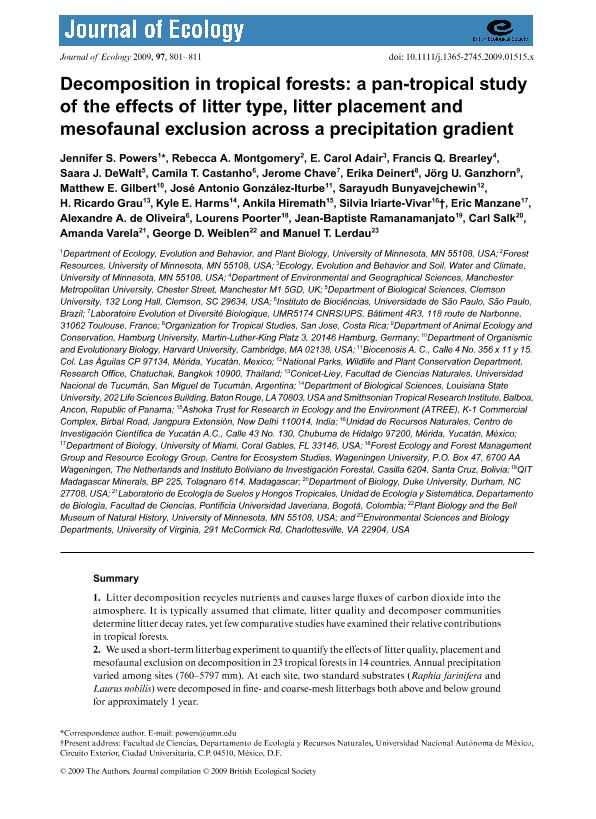Artículo
Decomposition in tropical forests: A pan-tropical study of the effects of litter type, litter placement and mesofaunal exclusion across a precipitation gradient
Powers, Jennifer S.; Montgomery, Rebecca M.; Adair, Carol E.; Brealey, Francis Q.; De Walt, Saarah J.; Castanho, Camila T; Chave, Jerome; Deiniert, Erica; Ganzhonr, Jörg U.; Gilbert, Mathew E.; Gonzalez Iturbe, José Antonio; Bunyavejchewin, Sarayudh; Grau, Hector Ricardo ; Harms, Kyle E.; Hiremath, Ankila; Iriarte Vivar, Silvia; Manzane, Eric; De Oliveira, Alexandre A.; Poorter, Lourens; Ramanamanjato, Jean Baptiste; Salk, Carl; Varela, Amanda; Weiblen, George D.; Lerday Manuel T
; Harms, Kyle E.; Hiremath, Ankila; Iriarte Vivar, Silvia; Manzane, Eric; De Oliveira, Alexandre A.; Poorter, Lourens; Ramanamanjato, Jean Baptiste; Salk, Carl; Varela, Amanda; Weiblen, George D.; Lerday Manuel T
 ; Harms, Kyle E.; Hiremath, Ankila; Iriarte Vivar, Silvia; Manzane, Eric; De Oliveira, Alexandre A.; Poorter, Lourens; Ramanamanjato, Jean Baptiste; Salk, Carl; Varela, Amanda; Weiblen, George D.; Lerday Manuel T
; Harms, Kyle E.; Hiremath, Ankila; Iriarte Vivar, Silvia; Manzane, Eric; De Oliveira, Alexandre A.; Poorter, Lourens; Ramanamanjato, Jean Baptiste; Salk, Carl; Varela, Amanda; Weiblen, George D.; Lerday Manuel T
Fecha de publicación:
07/2009
Editorial:
Wiley Blackwell Publishing, Inc
Revista:
Journal of Ecology
ISSN:
0022-0477
Idioma:
Inglés
Tipo de recurso:
Artículo publicado
Clasificación temática:
Resumen
Litter decomposition recycles nutrients and causes large fluxes of carbon dioxide into the atmosphere. It is typically assumed that climate, litter quality and decomposer communities determine litter decay rates, yet few comparative studies have examined their relative contributions in tropical forests.
We used a short‐term litterbag experiment to quantify the effects of litter quality, placement and mesofaunal exclusion on decomposition in 23 tropical forests in 14 countries. Annual precipitation varied among sites (760–5797 mm). At each site, two standard substrates (Raphia farinifera and Laurus nobilis) were decomposed in fine‐ and coarse‐mesh litterbags both above and below ground for approximately 1 year.
Decomposition was rapid, with >95% mass loss within a year at most sites. Litter quality, placement and mesofaunal exclusion all independently affected decomposition, but the magnitude depended upon site. Both the average decomposition rate at each site and the ratio of above‐ to below‐ground decay increased linearly with annual precipitation, explaining 60–65% of among‐site variation. Excluding mesofauna had the largest impact on decomposition, reducing decomposition rates by half on average, but the magnitude of decrease was largely independent of climate. This suggests that the decomposer community might play an important role in explaining patterns of decomposition among sites. Which litter type decomposed fastest varied by site, but was not related to climate.
Synthesis. A key goal of ecology is to identify general patterns across ecological communities, as well as relevant site‐specific details to understand local dynamics. Our pan‐tropical study shows that certain aspects of decomposition, including average decomposition rates and the ratio of above‐ to below‐ground decomposition are highly correlated with a simple climatic index: mean annual precipitation. However, we found no relationship between precipitation and effects of mesofaunal exclusion or litter type, suggesting that site‐specific details may also be required to understand how these factors affect decomposition at local scales.
Archivos asociados
Licencia
Identificadores
Colecciones
Articulos(CCT - NOA SUR)
Articulos de CTRO.CIENTIFICO TECNOL.CONICET - NOA SUR
Articulos de CTRO.CIENTIFICO TECNOL.CONICET - NOA SUR
Citación
Powers, Jennifer S.; Montgomery, Rebecca M.; Adair, Carol E.; Brealey, Francis Q.; De Walt, Saarah J.; et al.; Decomposition in tropical forests: A pan-tropical study of the effects of litter type, litter placement and mesofaunal exclusion across a precipitation gradient; Wiley Blackwell Publishing, Inc; Journal of Ecology; 97; 4; 7-2009; 801-811
Compartir
Altmétricas



